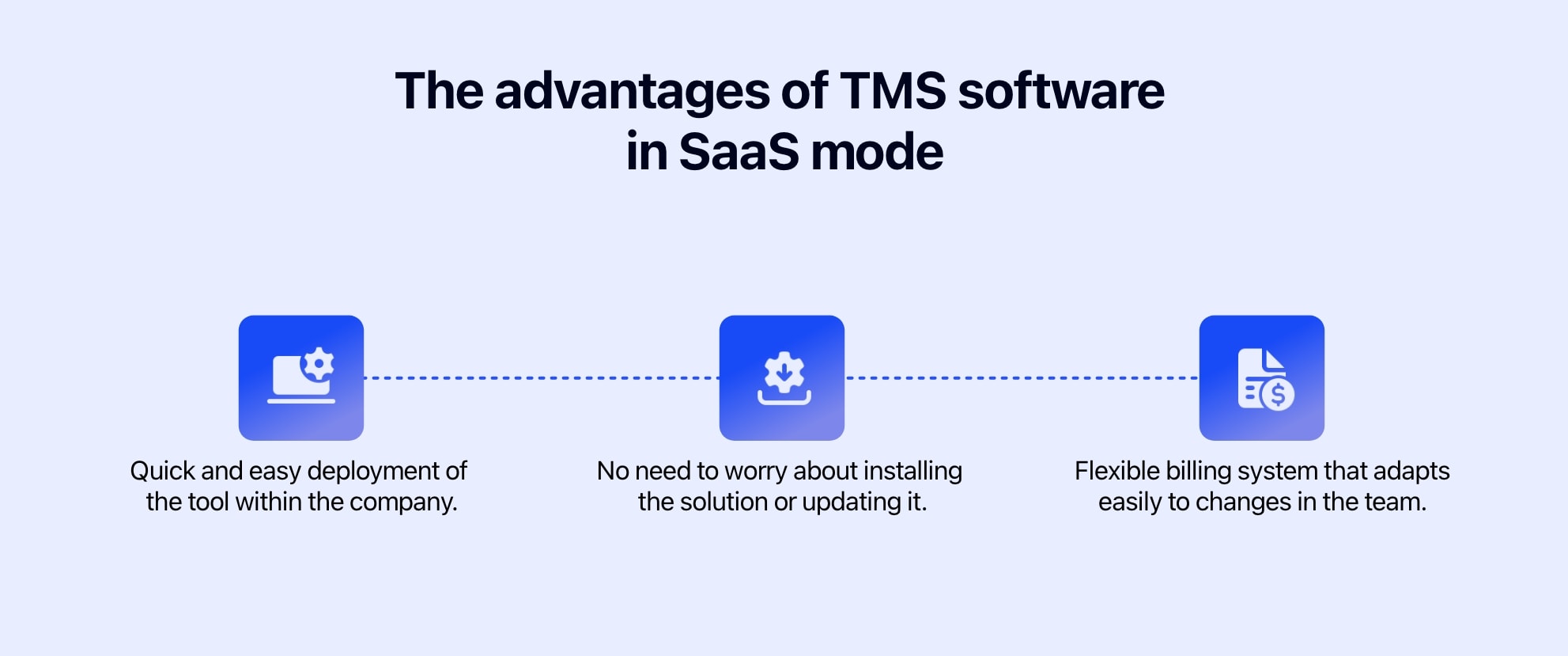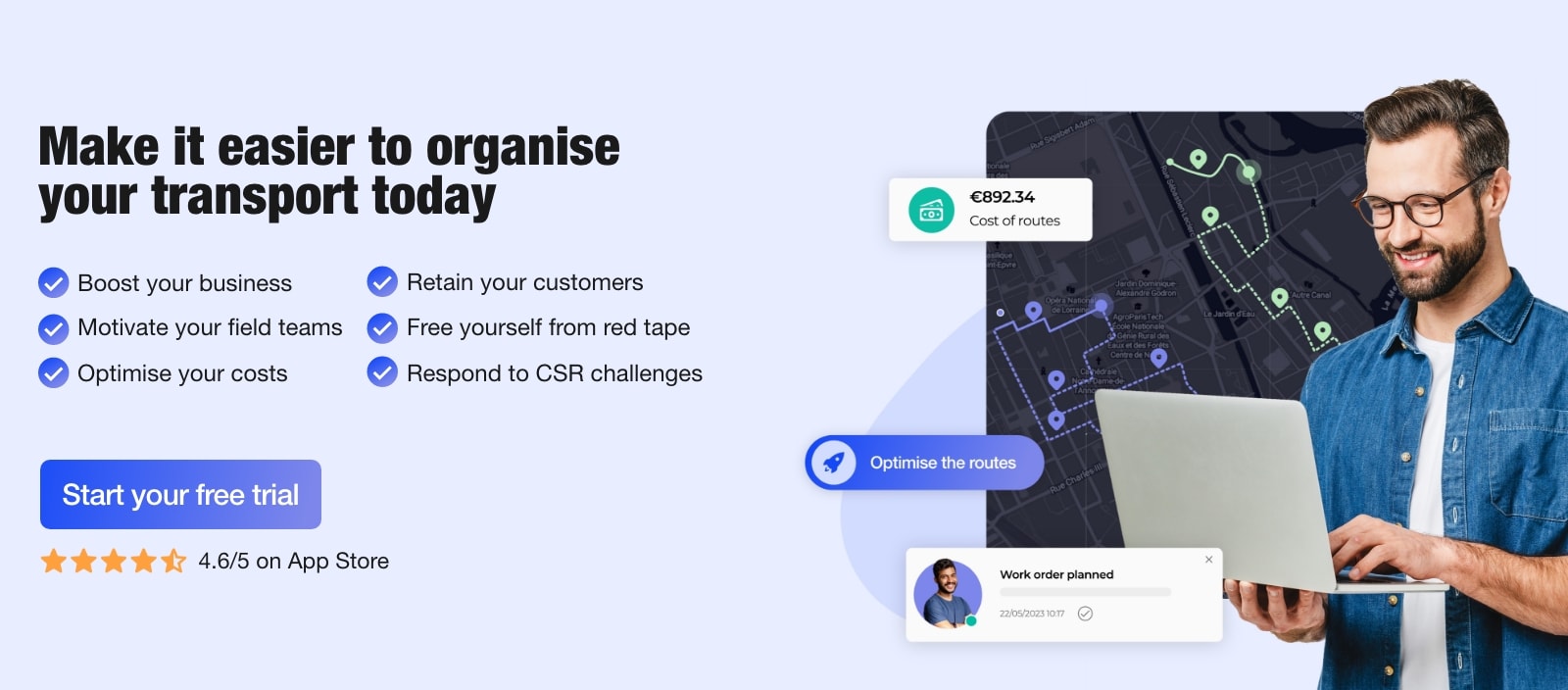What is a transport software (TMS) and how to choose the right one?
A transport software or TMS is a computerized management solution for the different stages of transportation. Here are the tips for choosing the right software.
Published on 31 May 2022 • Reading time: 8 min read
A transport software or TMS (Transport Management System) is a computerized monitoring solution for the different stages of transport. TMS belong to the large family of supply chain management software. The objective of these tools is to help you to optimize each step of the supply chain in order to reduce costs while ensuring quality of service.
Depending on your needs, a TMS can be integrated with an ERP (Enterprise Resource Planning) or a WMS (Warehouse Management System) to cover the entire supply chain.
Table of contents:
- What is the purpose of transport software or TMS?
- How to choose the best transport software for your needs?
Transport software or TMS optimises each stage of the supply chain. Transport TMS reduce logistics costs while maintaining service quality.
What is the purpose of transport software or TMS?
TMS offer solutions to better organize the whole or part of the logistic process, in order to save time and reduce costs. They also facilitate the exchange of information between stakeholders.
These tools therefore include several shared functionalities, but also more targeted solutions, adapted to different user profiles: forwarder, shipper, courier service provider, etc.
What are the shared functions of TMS?
Most transport software lets you manage the following operations in an automated way:
- Taking orders or making customer appointments.
- Scheduling pickup or delivery operations.
- Assigning shipments to carriers or delivery drivers according to different criteria (volume, weight, time, price, etc.).
- Real-time tracking of round-trip flows (track and trace).
- Managing the fleet of vehicles or ships.
- Transmitting and archiving transport documents and proofs of delivery in digital format.
- Monitoring issues: delays, cancellations, reservations, disputes, etc..
- Communicating with customers.
- Pre-billing or even direct billing of transport lines.
- Calculating and analyzing performance (KPI): cost per weight or per km, carbon footprint, statistics for each driver, etc.

The functions of TMS (Transport Management Software).
What is the difference between a shipper TMS and a provider TMS?
Although, TMS provide quite similar services, some of them nevertheless focus on one or another category of features depending on the type of users targeted. Transport professionals can therefore distinguish between:
- TMS shippers or loaders. These TMS are designed for companies that need to transport large quantities of goods, but for which transport is not the core business. They can be manufacturers, retailers, producers, etc. The developers of this type of solution will logically focus on features that enable efficient communication with carriers: sending of request for proposals directly or through freight exchanges, analysis of responses, selection of the most competitive carrier, etc.
- TMS providers or carriers. These tools are dedicated to professionals who give priority to the optimization of the transportation itself. They can be experts in road or air transport or inland navigation, but also companies where the delivery is an important part of the service provided (home delivery of meals, installation of household appliances, medical equipment, etc.). Depending on the customer’s request, the system will focus on optimizing the loading rate, reducing transport costs, quality of service, etc.

TMS shippers are designed for companies wishing to outsource the transport of large quantities of goods.
What is the difference between a route optimization software and a TMS?
The main objective of a route optimization software is to determine, taking into account the constraints related to customers and the industry, the best possible route for each driver.
As the development continues, some route optimization software offers more and more features in addition to the “basic” calculation of an optimal transportation route. Software such as AntsRoute, for example, includes tools for tracking packages in real time, gathering and managing proof of delivery, communicating with the end customer, etc. As route optimization is a key function of transport management in certain businesses, the functional scope of optimization tools is increasingly similar to that of TMS.
In contrast, some TMS include a route optimization function. However, many transportation software only offer sub-systems such as dispatching. In other words, they do determine transport routes, but the roadmap is not necessarily the right one! Therefore, experienced TMS buyers will have to ask the publishers precisely about this point.

Delivery route optimised with AntsRoute software.
How to choose the best transport software for your needs?
The best transportation software for your business is the one that will save you the most time by automating as many operations as possible. But if you’ve never used a TMS before, or if you’ve been using the same one for years, it’s not easy to take a step back and figure out what is really important!
If you are in this situation, our 5-step guide should save you a lot of headaches.
1. List the logistics processes to be automated
To choose the right software, you need to know what you are expecting from it. One effective solution is to list the operations that are currently causing you problems:
- “Planning the routes takes me too much time”.
- “I have difficulties to know if my transport orders are correctly performed”.
- “My drivers are always complaining about the app”.
- “Customers call regularly to check on the status of their delivery”.
- “My software does not have a module for freight exchanges”, etc.
You can easily determine which processes need to be improved, and make a list of the features you really need. For instance, all software automatically triggers some actions each time a condition is met. For example, “if the goods are loaded in the truck, send an SMS or an email to the customer”. Assuming that the system has received the information about the loading of the goods…
This type of automatic information sharing during pickup or delivery saves your teams valuable time. Pay attention to it!
2. Check the matching between the selected software and your business
Among the dozens of supply chain management tools available, some are adapted to a wide range of activities, while others are designed for a single industry. For example, the logistics processes of a medical analysis laboratory and a package delivery expert seem quite similar. However, for the preparation or delivery stages, the terms used will be different. Such mismatches are confusing for users on a daily basis, and ultimately waste a lot of time.
Furthermore, “twisting” a software to adapt it to another industry does not make it possible to use its full potential. Considering the large choice in this market, it would be a shame…
To check if the software is well tailored to your business, you can :
- Read “case studies” or “testimonials” on the website of the service provider.
- Ask the publisher for referrals from other customers in your industry.
- Check on screenshots the terms used, and ask to what extent the vocabulary can be customized
3. Compare the functions available
At this stage, you should already be able to establish a short list of 3 to 5 solutions. Now it’s time to compare the list of features that are essential for you and those offered “as standard” by each publisher.
For example, the recurring delivery of meals to schools requires very precise tracking of shipments. On a day-to-day basis, this feature will be much more useful than route optimization, since the routes of the drivers do not change often.
On the other hand, a company that delivers fresh produce at home on order will absolutely need to optimize its routes to be profitable.
In other words, the objective is not necessarily to find a multi-functional Swiss knife, but rather a tool focused on the features that are really important to you.
4. Check the quality of the support provided by the publisher
From one end of the supply chain to the other, most software is now offered in SaaS mode. In other words, the publisher directly hosts the solution and makes it available to customers in the cloud.
This distribution method has many advantages for customers whose core business is not IT:
- The implementation of the tool in the company is simple and fast.
- The customer does not have to worry about installing the solution or updating it.
- The billing system is very flexible and can be easily adapted to the evolution of the team, etc.

The advantages of TMS software in SaaS mode.
But this SaaS mode also makes you more dependent on the publisher. Here are some useful questions to ask beforehand:
- How can you test the software? A demo carry out by a sales representative? A free trial period?
- What are the solutions provided to support the teams in getting used to the tool?
- In case of difficulties, what help is available? Do you benefit from the assistance of a bot or a human being? What are the days and hours of operation of the hotline?
- How can I contact the customer service? By phone or by message only? Is the call surcharged?
- What are the commitments of the publisher in terms of availability? A service provider who guarantees 98% availability may seem impressive. But in concrete terms, this means that you agree to do without the software for one week a year…
- In the event of a breakdown, what guarantees does the service provider have in terms of response time and restore time?

The questions to ask yourself to check the quality of the publisher’s support.
5. Avoid using too many software tools
In your search for the best transport software, you should also consider the availability of APIs (Application Programming Interface). Behind this rather complicated acronym is a very clever IT solution that allows software to automatically retrieve data or a service provided by a third-party application. APIs allow you to get the best of each software and to build a case-by-case IT ecosystem perfectly tailored to your needs.
Thus, a route optimization software equipped with a good API can get the features you are missing, and even go further than a basic TMS. Thanks to its “open REST” API, AntsRoute can easily exchange data with :
- Very specific business software. For example, Must-G5, a management software for home health care providers, is integrated with our solution for optimizing routes using an API.
- e-commerce solutions like Prestashop and WooCommerce.
- More general tools already used in many industries such as Odoo, Outlook, Google Calendar, Google Maps, etc.
If necessary, it is recommended to ask each publisher about the possibilities of integrating with the IT solutions that you already use. This way, you won’t get stuck in a limited ecosystem, with no possibility to evolve.
Is your SME looking for a powerful tool to optimize its transport routes? The AntsRoute software and application can be adapted to any type of road transport, whatever the goods to be picked up, delivered or installed. Try it free for 7 days !
Optimise your transport routes today
Free 7-day trial | No credit card required




